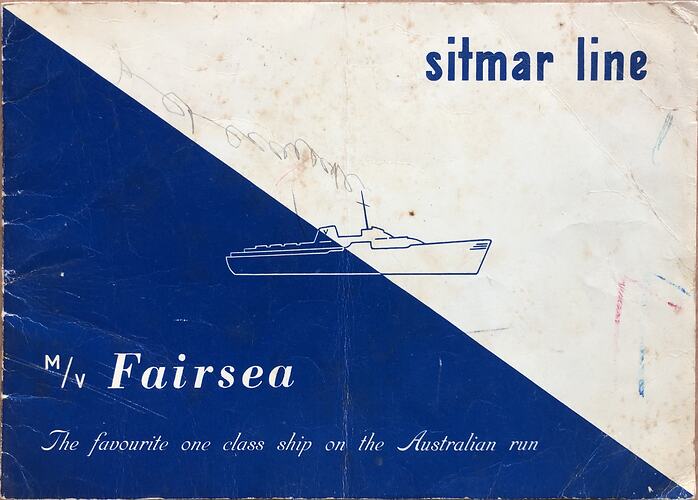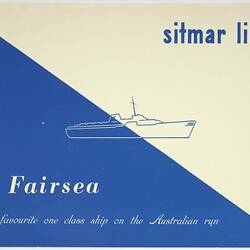Summary
Promotional booklet for the M/V Fairsea of the Sitmar line, published in October 1957. It includes a description of the ship's amenities and full colour photos of the ship's interior - cabins, lounges, bars, and dining rooms.
MV Fairsea holds an important place in the memory of many immigrants to Australia from the post-WWII period, having made a total of 81 voyages to Australia between 1949 and 1969. After completing several journeys under the International Refugee Organisation (IRO) from 1949 to 1951, bring out displaced people from European refugee camps, she was chartered by the Australian Government for the transport of assisted British immigrants, becoming the first non-British ship employed in this role. The Fairsea was also notable as the first passenger ship in the fleet of the famous Italian-owned Sitmar Line and as one of the first diesel-powered passenger ships to enter service between Europe and Australia. Although gaining an early reputation for rather stark and austere accommodation standards, inherited from her earlier career as a troop carrier during WWII, in 1957 the Fairsea underwent a major refit at Genoa emerging transformed into a fully air conditioned, elegant and comfortably appointed single-class ship, remembered with delight and a sense of adventure by the tens of thousands of immigrants and tourists who travelled on her over the next 12 years.
Physical Description
Staple-bound soft-cover landscape format booklet, 60 pages, with full colour illustrations throughout. Limited colour offset print, with cover illustration in printed in blue ink on a glossy white coloured card, and internal pages printed in full colour on white stock. The front cover features a stylised outline of the MV Fairsea's ship profile sailing from left to right cross a rectangle divided diagonally into blue and white triangles. The inside features full colour photos of the ship's interiors and deckboard recreation spaces.
Significance
The MV Fairsea holds an important place in the memory of many immigrants to Australia from the post-WWII period, having made a total of 81 voyages to Australia between 1949 and 1969. After completing several journeys under the International Refugee Organisation (IRO) from 1949 to 1951, bring out displaced people from European refugee camps, she was chartered by the Australian Government for the transport of assisted British immigrants, becoming the first non-British ship employed in this role. The Fairsea was also notable as the first passenger ship in the fleet of the famous Italian-owned Sitmar Line and as one of the first diesel-powered passenger ships to enter service between Europe and Australia. Although gaining an early reputation for rather stark and austere accommodation standards, inherited from her earlier career as a troop carrier during WWII, in 1957 the Fairsea underwent a major refit at Genoa emerging transformed into a fully air conditioned, elegant and comfortably appointed single-class ship, remembered with delight and a sense of adventure by the tens of thousands of immigrants and tourists who travelled on her over the next 12 years.
Published after the refurbishment in 1957, the brochure provides an evocative insight into the MV Fairsea accommodation maintained during the latter half of her career. The contents includes extensive colour photographs throughout providing a good indication of the standard of accommodation offered both in both twin and multi-berth passenger cabins and throughout public spaces above and below deck. These images provide an interesting contrast to the two large presentation albums of over 200 interior and exterior photographic views on the Orient Line's RMS Orcades (ST 042875) and to a number of other shipping brochures in the collection.
More Information
-
Collection Names
-
Collecting Areas
-
Publisher
Sitmar Line (Societa Italiana Transporti Marittimi S.p.A.), Genova, Italy, Oct 1957
-
Printer
-
Ship Depicted
-
Inscriptions
Cover Title: 'sitmar line M/V Fairsea The favourite one class ship on the Australian run'.
-
Classification
-
Category
-
Discipline
-
Type of item
-
Overall Dimensions
237 mm (Width), 170 mm (Height)
Landscape format - Dimensions measured when closed and held in upright position.
-
Keywords
Immigrant Shipping, Immigrant Voyages, Immigration, Shipping

